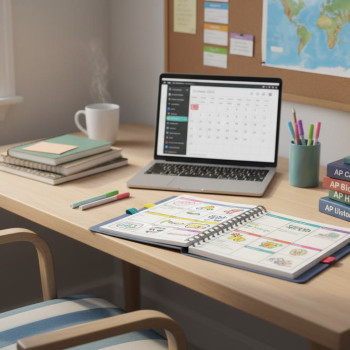Study Buddies: When They Help, When They Hurt
Why this matters for AP students
Preparing for an AP exam is a unique blend of content mastery, test-taking technique, and psychological endurance. Many students instinctively turn to friends and classmates for help — a natural response. Study buddies can be the spark that turns slogging review sessions into energizing learning. They can also be the distraction that turns precious weeks into frustrating, unfocused time. This article walks through the real benefits of study partners, the common pitfalls, and practical strategies to make group study work — including when you might want to lean on personalized tutoring like Sparkl’s 1-on-1 guidance and tailored study plans.

When study buddies help
1. They make motivation contagious
Motivation often has a social component. When a peer shows up on time, opens the textbook, and starts working, it’s contagious. For AP students balancing schoolwork, extracurriculars, and sometimes jobs, study buddies create accountability. A weekly group session can be the nudge you need to study consistently instead of cramming the night before the exam.
2. They surface gaps you wouldn’t notice alone
Explaining a concept to someone else forces you to organize your thoughts — often revealing gaps you didn’t realize were there. Likewise, hearing a classmate explain a tricky idea (like the nuance of U.S. History interpretations or how to set up a calculus optimization problem) offers alternative perspectives that can solidify your understanding.
3. They expose you to varied strategies
Different students develop different methods for approaching problems: mnemonic techniques for AP Biology, annotation strategies for AP Literature, or time-management hacks for a long AP Physics exam. In a productive study group, you collect a toolbox of strategies and can try the ones that fit your style.
4. They simulate test conditions and peer pressure
Some groups run mock exams, timed practice sections, or pass-around quizzes. These low-stakes simulations help normalize test nerves and teach pacing. Facing a timed FRQ (free-response question) in front of others — then discussing the answers — is one of the fastest ways to improve exam performance.
When study buddies hurt
1. When socializing outweighs studying
The biggest risk is simple: the session becomes social hour. Laughter and relaxation are essential, but if your group spends 60% of the time sharing memes or off-topic stories, your effective study time suffers. If grade goals or college plans depend on AP scores, that wasted time is costly.
2. When groupthink masks misunderstandings
Groups can create a false sense of consensus. If most students in a group misunderstand a concept in the same way, an explanation that just reinforces the misconception can spread quickly. Without a knowledgeable corrective — a teacher, tutor, or well-prepared member — that incorrect understanding becomes cemented.
3. When pacing mismatches create frustration
Some students breeze through review; others need a slower pace. If your group moves too fast, you’ll be left behind. If it moves too slow, you’ll feel bored and waste time. This mismatch can lead to frustration, anxiety, and either passive attendance or avoidance of group sessions altogether.
4. When cheating and dependency appear
Relying on a buddy to do difficult assignments or to produce answers for practice undermines learning. Worse, in the stress of an AP exam or its long-form essays, dependency on others’ shortcuts leaves you exposed. Group work that substitutes for your own practice can be a hidden harm.
How to know whether a study buddy is right for you
Quick self-check: five questions
- Do I leave the session with clearer understanding or just entertained?
- Is our time together structured (agenda, tasks, timed work), or free-form?
- Do members of the group hold each other accountable without judgment?
- Are misunderstandings corrected, and do we consult reliable sources when unsure?
- Do I still practice on my own outside the group?
If you answer “no” to more than one of these, reconsider how the group functions — or whether you should switch to partner or solo study.
Designing a high-impact study buddy session
Start with a tiny contract
Spend 5 minutes setting expectations each week: start time, topics, and rules (no phones during timed practice, for instance). A short agreement prevents drifting into social mode and gives each member permission to call the group back to work.
Use an agenda and divide responsibilities
Assign roles: one person times practice sections, another prepares an outline of the content to be reviewed, another brings practice problems. Rotate roles so everyone practices teaching and leadership. A simple agenda might look like:
- 10 minutes — quick check-in and goals
- 30 minutes — focused, timed practice (e.g., 30-minute multiple-choice set)
- 20 minutes — discuss answers and reasoning
- 15 minutes — targeted review of the weakest concept
- 5 minutes — assign individual follow-up
Make practice deliberate
Deliberate practice means focusing on the hardest parts and getting immediate feedback. Instead of re-reading chapters, use practice problems, past FRQs, or quizzes. After each timed run, identify one micro-skill to improve (e.g., creating clearer thesis statements for AP Lang essays or setting up equilibrium tables in AP Chemistry).
Use the table below to track group effectiveness
| Metric | Good Sign | Bad Sign | What to Do |
|---|---|---|---|
| Attendance | Most members attend and arrive on time | Frequent cancellations or late arrivals | Reinforce commitments or switch to smaller, more reliable group |
| Productivity | Clear outputs each session (practice scores, notes) | Sessions finish with no measurable progress | Create an agenda and set mini-goals |
| Learning | Members can teach back concepts | Same mistakes repeat across sessions | Bring in an expert resource (teacher, tutor) or authoritative materials |
| Energy | Focused energy and respectful interruptions | Either drained or hyper-social atmosphere | Shorten sessions or split into focused sprints |
Practical formats for study buddy groups
1. The Pair (Best for precision)
Two students complement each other well: one explains, the other questions. Pairs work great when you need targeted feedback or to run timed essays and then give critique. If you’re leaning on a partner too much, set a rule: after group time, each person must complete one independent practice set alone.
2. The Small Squad (3–5 people)
This is the sweet spot for many AP subjects. You get diversity of thought without chaos. Use breakout tasks — each person masters a subtopic and then teaches it in five minutes. Rotate weekly so everyone practices teaching and gains confidence.
3. The Class-Level Review (6–12 people)
Large groups are excellent for mock exams and community Q&A but poor for deep learning. Reserve large sessions for two to three times before the exam for practice tests, and otherwise stick to smaller study groups for skill building.
When to call in expert help
Signs you should get a tutor
- Repeated incorrect answers on multiple practice tests despite group review.
- High anxiety that doesn’t improve with practice — performance worsens under time pressure.
- Content gaps that no one in the group can reliably explain.
- Time is limited and you need a targeted, efficient plan.
Here’s where Sparkl’s personalized tutoring fits naturally: when groups help with motivation and peer teaching but can’t replace focused, individualized instruction. Sparkl’s 1-on-1 guidance, tailored study plans, expert tutors, and AI-driven insights can zero in on your unique weak points and accelerate progress without wasting group time.
Tips to keep group study effective and fair
1. Rotate leadership and teaching roles
Everyone gains more when they practice explaining concepts. Rotate who teaches a mini-lesson each week so no single student becomes the group’s permanent “answer bank.”
2. Use technology wisely
Shared documents, digital flashcards, or a collaborative calendar can increase efficiency. But avoid excessive multitasking: phones and social apps are attention predators during study periods. Put them away during timed practice sprints.
3. Keep sessions short and focused
Human attention declines after about 45–60 minutes without a break. Use the Pomodoro technique (25–30 minute focused sprints followed by 5–10 minute breaks) to maintain high-quality work during group sessions.
4. Make group norms explicit
Agree on norms: punctuality, no phones during practice, and a respectful critique method (compliment, suggest, ask). This reduces awkwardness when someone needs to point out gaps.
How to measure whether your study buddy approach is working
Short-term indicators
- Rising scores on timed practice sets.
- Fewer repeated errors on the same topic after review.
- Clear, concise explanations from different members (teach-back ability).
Long-term indicators
- Practice exam score trends moving toward target AP score.
- Reduced test anxiety and improved pacing on full-length practice tests.
- Comfort with a variety of question types and the ability to self-correct during practice.
Sample weekly plan combining solo study, study buddies, and tutoring
| Day | Activity | Purpose |
|---|---|---|
| Monday | Solo focused review (45 minutes) + 15-minute flashcards | Target weak concepts and build recall |
| Tuesday | Pair session (50 minutes) — practice problems + explain back | Deepen understanding through teaching |
| Wednesday | Individual practice test section (timed) + self-review | Assess pacing and accuracy |
| Thursday | Small group (90 minutes) — mock timed set + group discussion | Simulate exam conditions and learn strategies |
| Friday | One-on-one tutoring (Sparkl’s tailored session) — 45 minutes | Targeted help on persistent weak spots and personalized plan |
| Saturday | Rest or light review (essay outline practice) | Prevent burnout and solidify retention |
| Sunday | Full-length practice test (monthly) or catch-up | Measure progress against goals |
Dealing with anxiety, competition, and comparison
Turn comparison into inspiration
It’s natural to compare scores or to feel competitive with friends. Use that energy constructively: ask the high-performing peer to demo a strategy, rather than letting the comparison spiral into discouragement. Celebrate small wins as a group.
Protect your mental bandwidth
If group dynamics cause stress — relentless comparisons, pressure to keep up, or judgment — prioritize your mental health. Sometimes stepping back from a group, or choosing a different set of partners, is the best decision for your exam performance and wellbeing.
Final checklist: Make your study buddies work for you
- Agree on a short weekly agenda with clear outputs.
- Rotate roles so everyone practices explaining and leading.
- Use timed practice and immediate feedback to anchor learning.
- Bring authoritative resources or an expert when misconceptions persist.
- Balance group sessions with solo deliberate practice and, when needed, targeted tutoring like Sparkl’s personalized plans.

Parting thought
Study buddies are neither magic nor menace — they’re a tool. Used thoughtfully, they create accountability, accelerate learning, and make the grind more human. Used carelessly, they eat time and spread confusion. Design your study groups like you design any experiment: start with a hypothesis (this group will improve my practice test score by X points), measure results, and iterate. If you find the group energizes and elevates you, keep it. If it doesn’t, tweak the structure or bring in targeted help. Your AP success isn’t just about hours logged — it’s about the quality of those hours. Find the mix of solo work, focused groups, and expert guidance that gets you to your goal, and treat every session as an investment in that outcome.
Invitation
If you’d like help designing a study plan that blends group study with focused tutoring, consider a tailored approach: a clear agenda for your study buddies plus occasional 1-on-1 sessions for the toughest topics can produce steady, measurable gains. A little structure goes a long way — and with the right mix, study buddies become your strongest allies instead of your biggest risk.
















No Comments
Leave a comment Cancel